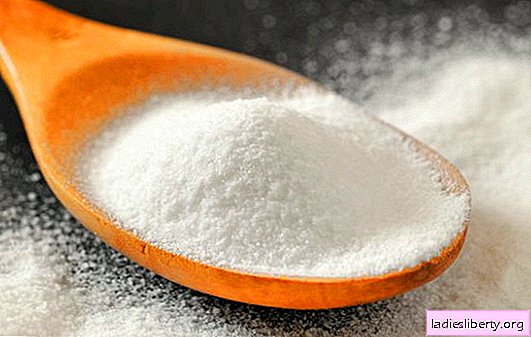
A big city, a city of angels or a city of demons, it doesn’t matter, squeezes out all the juices from their men and women, saturating with junk food, stress and illness. Living in such an aggressive environment for itself, the inhabitant must carefully monitor his diet. Understanding the obvious, he / she at some point thinks about sweets. During a long match, it turns out that sugar should be excluded from the diet or replaced. One of the modern sweeteners is erythritol - and it will be discussed in the article.
Erythritol is ...
A compound that looks almost like sugar, is available in powder or granule form, belongs to the class of sugar alcohols. This means that the molecule is similar to a hybrid of carbohydrate and alcohol (not to be confused with ethanol). There are many different sugar alcohols. They can be found in natural products, such as fruits, as well as in sugar-free products of all varieties. The way in which these molecules are structured enables them to stimulate the taste buds in the tongue. This is a common property for all sweeteners. But erythritol is a little different. First of all, it contains much less calories:
Sugar - 4 calories / gram;
Xylitol - 2.4 cal / g;
Erythritol - 0.24 cal / g.
At the same time, erythritol retains its sweetness, which is approximately 70-80% of regular sugar. And, due to its chemical structure, the drug is practically not absorbed by the human body. Therefore, it does not cause harmful metabolic effects similar to excess sugar or digestive problems associated with other sugar alcohols.
At this point, it should be noted that erythritol does not have any qualities that are useful to the human body and does not perform well-known functions. It is simply less harmful than sugar or other sweeteners.
Erythritol is absorbed into the bloodstream, and then excreted unchanged in the urine in an amount of 80-90%, the rest is excreted through the intestines. It has a zero glycemic index and does not change blood sugar or insulin levels. Also does not affect cholesterol, triglycerides and other biomarkers. This suggests that erythritol is a good alternative to regular sugar for overweight people or diabetes.
Some people add erythritol to home baking, as the melting point is around 120 ° C, and also combine it with stevia. Erythritol baked goods have a characteristic “cooling” taste. This effect is observed due to the high heat absorption at the time of dissolution of the compound. This makes erythritol an interesting addition to mint.
Another “plus” in the erythritol basket is its zero impact on the teeth. The bottom line is that the harmful bacteria that live in a person’s mouth must eat something. Erythritol, unlike sugar, does not feed bacteria in the oral cavity, they cannot digest it. And when these bacteria do not have enough energy, they do not grow, do not multiply and do not secrete acids that destroy tooth enamel.
Bacteria of the large intestine also do not receive “additional nutrition” for the reason that about 75% of erythritol is rapidly absorbed unchanged into the blood even in the small intestine. And the part that comes to most bacteria is too tough for them. The intestinal microflora cannot ferment erythritol, or has not learned yet. Here is such an interesting substance. At the same time, it is quite well tolerated by the body. And, unlike other sweeteners, such as sorbitol or xylitol, in small quantities does not cause digestive upsets and diarrhea.
Negative sides and harm
A large single dose of the sweetener (50 g = 2 tablespoons) can cause nausea and fatigue of the stomach, as well as, in some people, diarrhea, abdominal pain and headache. It must be understood that the final amount necessary for the onset of symptoms is very dependent on individual tolerance. You need to "accustom" yourself to erythritis gradually.
Also, despite the fact that the sweetener, roughly speaking, is calorie-free, it can still be associated with obesity or diabetes in the long term. The mechanism of action in this case is very simple: when a person has eaten food, his brain registers what he ate, signals his body to release hormones that reduce appetite. For the reason that erythritol passes through the body in an undigested form, the brain will not give the same saturation signals, which causes a regular, "digestible" sugar. This means that a person can continue to feel hunger and eat more, thereby harming himself. And this is no longer part of a healthy or low-calorie diet.
Advice! At the time of purchase, make sure that erythritol is not a GMO product. Animal studies draw a clear line between GMOs and infertility, immune problems, accelerated aging, impaired insulin regulation, and changes in major organs and the digestive system.
Most of the erythritol used today in foods and beverages is derived from corn starch from genetically modified corn.
Erythritol is not as sweet as sugar, so it is often combined in foods and drinks with other dubious sweeteners, usually artificial ones. When combined with artificial sweeteners such as aspartame, an erythrol-rich product becomes more harmful to your health. Side effects of aspartame include anxiety, depression, short-term memory loss, fibromyalgia, weight gain, fatigue, brain tumors, and more. Since products containing erythritol also typically contain artificial sweeteners such as aspartame, the side effects of this particular product or drink become more harmful as well as dangerous. The substances on the product label can be identified by the indices: E968 - erythritol, E951 - aspartame.
Be careful and careful.
Alternatives
In its natural form, erythritol is found in some fruits and fermented products, such as: watermelon, grapes, pear, mushrooms, cheese, wine, beer, etc. "Melon sweetener" erythritol is called because it is obviously found in large quantities in melons from which it is also obtained. However, the problem is that the vast majority of erythritol used in products today, as already mentioned, is made by humans by processing glucose (most often from GMO corn starch) and fermenting it with yeast or another fungus. Therefore, still the best alternative to sugar, sweeteners and tambourine dances are ordinary fresh fruits, vegetables, berries and raw honey.
In general, erythritol itself is a fairly safe sweetener, almost harmless. It does not have pronounced positive properties, as well as negative ones, which sugar, for example, has. At the same time, due to its advantages, erythritol can take a confident position on the shelf in the kitchen near the sweet tooth, replacing sugar or any other sweetener. However, it is still not good enough for the human body. In addition, there is a risk of running into GMOs.











